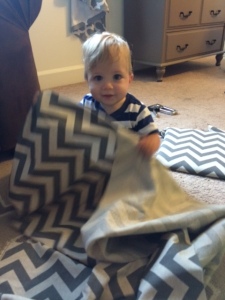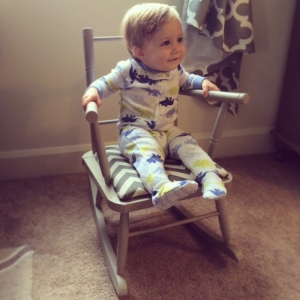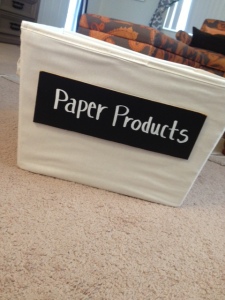
Finally! I am so excited to share my laundry room and command center transformation with you! Now it may not seem like much of a “transformation” to you, but in the short time that we had been living in this home pre-transformation this room was one of my least favorite rooms in the house. Not only is the room barely big enough to fit a standard size washer and dryer, it quickly became the catch-all and family dumping area of the house, anything that didn’t have a place would just get tossed in the laundry room. I was on a mission to fix this problem room because as much as I disliked the laundry room, I knew that if I was successful in transforming the room it would be so wonderful to finally have an actual “laundry” room as opposed to having the washer/dryer hook-ups in the garage as it was set up in our last home. Additionally, I was super excited to draw inspiration from so many of the amazing laundry room and command centers that I’ve seen on Pinterest but were never able to apply to our Honey Tree home.
A lot of this project was simply de-cluttering and organizing the space. With the addition of a few storage solutions and DIY decor I was able to transform the space for very little money (and it was worth every penny! lol). The “command center” was just my little addition to help organize our random to-do lists, receipts, coupons etc. and centralize all of the little “hey-where-the-heck-did-I-put-that ______?!” items. Oh, and to display a calendar of course, which is a great point of fascination to my hubby who had no idea how busy our lives were, haha! I hope this inspires a transformation on your end, you will be amazed at how easy this project was and even more amazed at how much it has organized us with just a few small additions to a tiny under-utilized space. Check out my pictures below for DIY ideas and links to their tutorials, as well as sources for all of my decor!

Before! Okay, I know a lot of this transformation ha to do with organization lol but I think a lot of people can agree that the mudroom tends to become a family dumping ground for miscellaneous items and I was determined to change that!

After! Organized and stylish, if I do say so myself 🙂

Command area, before and after!

Laundry area, before and after.

See sources below to see where I found these free printables!

Follow this link to find see how I went about creating this sign!

These serve no purpose other than to cover up the ugly wall and washer hook-ups behind them but I think it adds a little pretty somethin’ to the room 🙂

These descriptive chalkboard signs are held on to the totes by magnets, the perfect thing for me since we are not staying here long and who knows what we’ll be using these bins for in our next home. Follow the link to see how I made them!

DIY calendar I made using paint chips, unfortunately I didn’t have my day planner handy so I could only remember two things we have to do this month, haha, obviously I REALLY need this calendar! lol This picture links to my tutorial so check it out, this project is basically free!

This transformation cost me somewhere in the neighborhood of $200.00, however, to permanently organize and stylize this room using items that can easily be reused wherever we end up next, it was a small price to pay! That being said, a similar look can be achieved for next to nothing if you’re open to different color schemes and products.

1 // Fabric Totes with Magnetic Chalkboard Signs – Totes available here via Amazon for $13.97 each. These were a little pricey but were exactly what I was looking for, they are sturdy, just the right size and will I will definitely be using them in our future homes. The magnetic chalkboard signs were a little DIY addition that I came up with out of necessity for these bins, check out my tutorial here.
2 // Fabric Curtains/Wall Coverings – These do not serve an actual purpose other than to cover the ugly water hook ups and white wall behind them. I simply used left over fabric from my living room curtains using the same method as I did when creating my sink skirt, just added little loops of ribbon to hold the decorative shower curtain hooks (available here via Amazon for $7.64, lots of other colors available!) I used to hang the curtain from the wire shelving.
3 // Sink Skirt – This is a DIY project I finagled to cover the ugly laundry sink using left over fabric from my side-light curtains, check out my link to see how I made it!
4 // Chevron Rug – Available here via Overstock for $35.49.
5 // Ironing Board Holder – The perfect thing to free up space for the bins above the washer/dryer. Available here via Amazon for $34.99.
6 // Ironing Board Cover – Purchased at Walmart for $7.50. It was just a coincidence that it happened to match my wall coverings perfectly!
7 // Family Bulletin Boards – Available here via Amazon for $6.53, I attached them to the wall using Command picture hanging strips. I personalized them using unfinished letters from Walmart ($1.97 each) that I spray painted white and attached to the boards using hot glue.
8 // Large Striped Totes – Available here via Target, $25.98 for a set of 2. I used the fourth bin as extra toy storage for baby P. These bins are perfect for holding our daily items (pocketbook, keys, wallet, hats etc.) so that we need not leave them randomly about the house. I used left over chalkboard favor tags to label each with our initials.
9 // Dry Erase Paint Chip Calendar – Check out my post to find out how I made it!
10 // Laundry Room Printables – I printed and framed these two free printables I found via Pinterest: “This home has endless love and laundry” and “Laundry, drop your pants here”.
11 // White Floating Shelf – Originally purchased at Home Depot, I reused one from our guest bathroom update on our Honey Tree house.
12 // Metal Wall Mounted File Holder – Purchased via Amazon and available here for $25.00. It is very helpful in organizing receipts, coupons etc.
13 // Candy Jars – Used for holding detergent pods and dryer sheets. I purchased mine at Walmart for $2.98 each.
14 // “Schulze Central Command” Hand Painted Sign – Check out how I made this sign by reading this post!
15 // Wall Clock – Cheap-o wall clock purchased from Walmart for $2.98! Gotta love all that cheap back-to-college dorm decor!






















































































